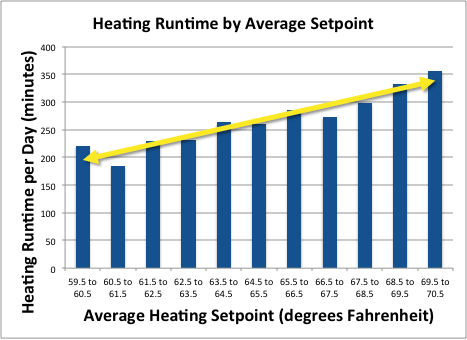
Laura Kier
May 16, 2012
Spring has sprung throughout most of the country by now. As trees started to blossom and animals began to emerge from hibernation, our data analysis team here at EnergyHub headed back into their caves to dissect a winter’s worth of thermostat data.
We’re grateful to the DOE, EPA, and other government and industry organizations for making some valuable predictive models for heating and cooling. For example, the DOE’s Energy Savers website says that you can generally save 3% on your heating bill for each degree that you turn your thermostat down during the winter. With the billions of data points that our Mercury smart thermostat platform collects every month, EnergyHub’s in a unique position to see how well heuristics like that stack up to reality.
If you want to skip the rest of this post, here’s what you need to know: in some cases, you could save a lot MORE than 3% for each degree that you lower your heating setpoint.

Here’s how it works: we looked at all of the Mercury-connected thermostats deployed across the great state of Michigan from early February through early March. For each thermostat, we calculated the average scheduled setpoint for each day, along with the number of minutes that the HVAC system was actually heating the house that day (called “runtime”).
If you’re curious what “average scheduled setpoint” means, consider the default program schedule from the latest ENERGY STAR Program Requirements for Residential Climate Controls by the EPA:
| Period | Time | Heating Setpoint |
|---|---|---|
| Morning | 6:00 am | 70 °F |
| Day | 8:00 am | 62 °F |
| Evening | 6:00 pm | 70 °F |
| Night | 10:00 pm | 62 °F |
With this schedule, the home would have a setpoint of 70 degrees for 6 hours each day (6:00-8:00 am and 6:00-10:00 pm) and 62 degrees for the remaining 18 hours. If you do a little math, that works out to an average setpoint of 64 degrees over the course of the day.
For our Michigan thermostats, we compared the average scheduled setpoint to the heating runtime for each day, and we found that runtime increased a little more than 14 minutes per day for each degree increase in average setpoint – costing about $10 per month per degree.1 Compared to Michiganders using the EPA default setpoint average of 64 degrees, this works out to be a 5.4% reduction in heating costs per degree decrease in the average setpoint.
In other words, our Mercury data shows that if you live in Michigan, you could have saved about $10 (more than 5%) off your monthly heating bill for each degree you turned your thermostat down. At $30 a month for a three-degree change, putting on a sweater starts to sound pretty appealing.

This analysis didn’t consider home size, furnace size or type, number of occupants in the home, and some other important factors, so your results may vary. Plus, not everyone lives in Michigan. Nevertheless, lower average setpoints are clearly better for most people.
Want to get aboard the savings train? Here are three ways to decrease your average setpoint and save some money on your heating bills next winter, no matter where you live:
- Lower all of your setpoints a little – when you’re home, when you’re away, and when you’re sleeping. Feeling chilly? Grab a Slanket!
- Increase the amount of time your thermostat is in its “away” state (the energy-saving temperature you use while you’re not home). You should definitely make this part of your programmed schedule, but you should also use this energy-saving temperature for weekend errands, vacations, and other less predictable times when nobody’s home. If you own a Mercury-compatible thermostat, it’s easy to Set Away for your entire house with a single tap/click on your mobile phone or web browser.
- Be more aggressive about lowering the heating temperature when you’re away from home. Try a 10-degree set-back instead of 8 degrees.
Whatever method you choose, lower is better, especially if you live in The Wolverine State.
On March 14th, the total cooling minutes for Mercury-connected thermostats passed the total heating minutes for the first time in 2012, and that can only mean one thing: air conditioning season is ramping up. Look for some “cool” content to come in future blog posts.

What was your best way to save energy this past winter? What questions or predictions do you have for air conditioning season this year? We’d love to hear your tips, thoughts, and questions. Hit us up at ilovedata@energyhub.com.
_____________________________________________________________________________
1. Natural gas is the most prevalent residential heating fuel in Michigan. A standard gas boiler consumes around 175 BTU per hour, which is about 175 cubic feet per hour. At $0.793 per 100 cubic feet of natural gas (as of April 2012), 14.329 minutes per day is worth about 33 cents. So, that’s around $10 per month.
Interested in keeping up with the latest dispatch from the grid edge?
Get our next post in your inbox.


